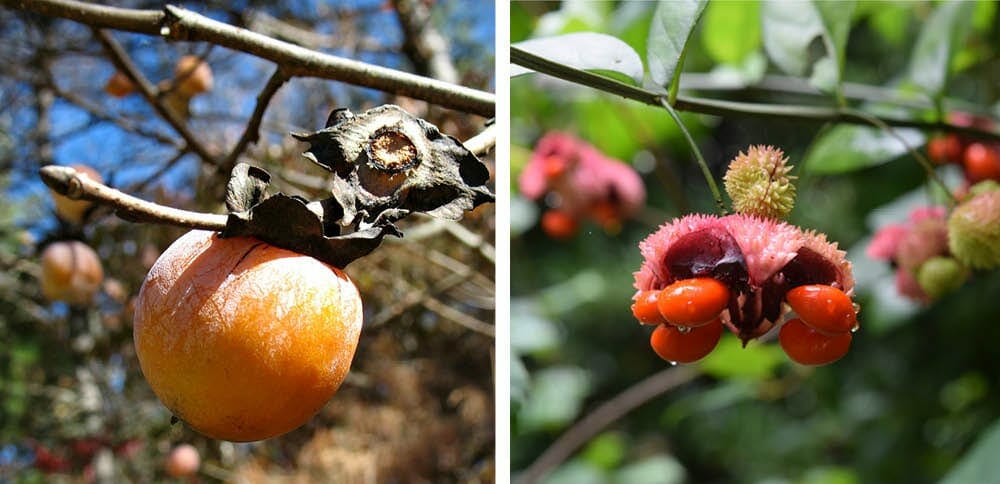Left: Ediible fruit of persimmon (Diospyros virginiana). Right: Fruit capsule of hearts a bustin’ (Euonymus americanus).
Fall is often a time associated with nice foliage colors, but I like to also appreciate some of the fruit that ripens in the fall. Appearing now like plump and colorful jewels are the fruits of wild persimmon, beautyberry, hearts a bustin’, winterberry, and viburnums.
Persimmon (Diospyros virginiana) is a dioecious tree (having separate male and female flowers) that produces small, orange fruits in the fall. Unlike grocery store persimmons from Asia, these little fruits must fully ripen before being eaten or your mouth will pucker. I try to gather them soon after they naturally fall to the ground.
Beautyberry (Callicarpa americana) was profiled in the September newsletter, so check out that earlier article if you missed it. The purple fruits are looking great right now.
Hearts a bustin’ (Euonymus americanus) is a shade-tolerant shrub with modest flowers and foliage but a thoroughly impressive fall fruit. In plant identification forums, id of this plant is a top query in the fall. The raspberry-colored, warty fruit capsule cracks open to reveal 4 fleshy, orange seeds that dangle. The fruits are a favorite of cardinals.
Left: Winterberry (Ilex verticillata) fruit clusters. Right: Drupes of southern blackhaw (V. prunifolium).
Winterberry (Ilex verticillata) is one our deciduous holly shrubs, another dioecious species that fruits only on the female plant. Good pollination, thanks to hard-working bees and the presence of a nearby flowering male plant, results in bright red fruits clustered along the stem. Once the leaves drop, the effect of the bright fruit on the branches is stunning.
Viburnums (Viburnum sp.) are wonderful native shrubs and several have fruit ripening now: southern blackhaw (V. prunifolium) and rusty blackhaw (V. rufidulum) are two large ones (suitable as small trees in urban yards) while shade-tolerant mapleleaf viburnum (V. acerifolium) is suitable for part-shade hedges.
Other fruiting plants include chokeberry (Aronia), southern crabapple (Malus angustifolia), and hawthorns (Crataegus). Many of these produce more fruit as a result of good cross-pollination so try to have more than one even when male/female plants are not specified. While not all of these fruits are suitable for humans, they all nourish our native wildlife: birds, possums, raccoons, foxes, chipmunks, squirrels and others.


